Basketball: Did You Know? – I
Dribble-Drive
Motion [posted 2/15/08]
It germinated in the Fresno Valley in California, blossomed in the Golden State, and has now swept the country. John Calipari of Memphis gave the offense its current name, Dribble-Drive Motion. But the originator was a high school, then juco coach named Vance Walberg. SI discovered 224 junior high, high school, college and pro teams that are running his offense in some form. Even the revered Jersey City high school coach Bob Hurley has switched to it after 22 state championships and over 900 wins. "It doesn't have to be mud-wrestling where just the stronger, more physical, more athletic kids win," he says. The offense puts four players on the perimeter with a post man. Each outside player goes to the goal when he gets an opening and then either continues to the basket, passes out to a 3-point shooter, or drops off the ball to the post man. There are few screens, which opens space for the penetrators. If you've watched basketball at any level the last couple of years, you've seen this offense in action. #1 Memphisruns a variation of it. The ironic twist to this story is that Walberg himself is unemployed since he resigned from Pepperdine last month midway through his second season there.
Biggest Twins in Basketball[posted 3/8/08]
Stanford has the largest pair of twins in college basketball in Brook and Robin Lopez. They come by their 7' height and athleticism naturally.
- Their mother, Deborah Ledford, is 6' 3/4" and
was an elite swimmer in her teens.
- Deborah's three brothers are between 6'8" and 6'10 1/2" tall.
- Her 6'7" father played college basketball but turned down an NBA tryout because the league didn't pay enough money in those days.
- Brook
and Robin's father, Heriberto Lopez,
is 6'5" and played baseball in his native Cuba.
- Heriberto's
6'3" cousin Marcelino Lopez pitched in the
majors from 1963-72.
- The twins' brother Alex is 6'10" and played at Washington and Santa Clara while their other brother Christopher, 6'7", played in high school.
Brook decided in the second grade that he would attend his mother's alma mater, Stanford. Both twins starred in volleyball
as well as basketball, earning McDonald's All-American honors at Fresno's San Joaquin Memorial High. Both have musical talent, Brook on sax and Robin on drums. Brook also likes the stage. However, their mutual passion is Walt Disney. They can answer
any question you can throw at them about the creator of Disneyland.
The sophomores will be 20 years old on April 1. |
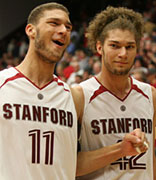 |
 |
The
athletic teams at St. Louis University
are called the Billikens.
Just what is a "Billiken"?
The
Billiken is an ancient Buddha-like Asian symbol of good luck that
became a national craze in the early 1900s. An art teacher, Florence
Pretz, received a patent for her version of the figure.
The Billiken Company of Chicago was formed to manufacture the figurines,
thus giving them their names. Billikens reached their peak of popularity
in 1911.
How
the name became associated with St.
Louis U. is not entirely clear. It is accepted that
the link dates back to 1910-11 at the height of the billiken craze.
The generally accepted version of the story pinpoints two St. Louis
sportswriters who thought the SLU
football coach, John Bender, bore a striking resemblance
to the impish creature. One of them drew a caricature of Bender
as a Billiken and began referring to the team as "Bender's
Billikens." When the fans took to the name, the school
adopted it.
Some
would say that the present Billiken
basketball coach, Rick Majerus, also resembles
the chubby cherub.
|
At
halftime of Cincinnati's first-round game in
the 2008 Big East Tournament at Madison Square Garden, the Bearcats and the Garden commemorated the 50th anniversary of Oscar
Robertson's first game at the old Garden (8th Avenue
and 48th Street). On January 9, 1958, Oscar,
a 19-year old 6'5" sophomore G, scored 56 points against Seton Hall to
set a Garden scoring record, college and pro.
Oscar hadn't expected to play at Cincinnati. After
leading his Crispus Attucks team from Indianapolis
to an undefeated state title, he was named National Player of
the Year for 1956. In his words, "I had always hoped to
play for Indiana University but Coach Branch
McCracken's racial attitudes intervened." Cincinnati coach Ed Jucker had no such hangups.
The
Garden was the sports equivalent of Broadway theater or Carnegie
Hall for music. MSG hosted the NIT Final Four (and in the 1950s
the NIT was every bit as prestigious as the NCAA Tournament),
championship fights, the Rangers and the Knicks. "If
you can make it there, you can make it anywhere," to quote
the song "New York, New York." Also there were very
few basketball games on TV, college or pro. Few people had actually
seen Wilt Chamberlain, Bill Russell, Jerry West, or Elgin Baylor.
So Oscar's performance in the media capital
of the world catapulted him and his team to national prominence.
Cincinnati's
118-54 rout of Seton Hall was the nightcap of a doubleheader in which Cincy's
crosstown rival, Xavier,
defeated another New York area team, Iona. Xavier returned
to the Big Apple later that season to win the NIT.
Coming
from basketball-crazed Indiana, Oscar was accustomed
to playing before rabid crowds. However, he was surprised by
New Yorkers' passion and knowledge of the game. "Although
black players in major college basketball were still a rarity
then, I also found a welcome absence of the racial invective
that came with the territory when you played in Indiana in the
mid-'50s."
A
strong argument can be made that "Big O" Robertson is the greatest player ever. (They say "pound-for-pound"
in football. So this would be "inch-for-inch.") He
is the only player to average a triple double (points, rebounds,
assists) for an entire NBA season (1961-2). He could, and did,
play every position on the court, including C. He could score
in the post against much taller defenders. His ball handling
was superb and his passing exquisite. |
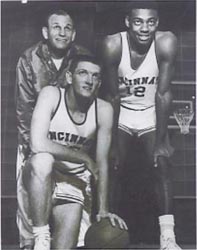
Oscar Robertson (R) with Coach Ed Jucker and a Bearcat teammate
|
"When the Big O First Played the Garden: 56 in '58," by
Oscar Robertson, New York Times, 3/9/08 |
Let's
start with a question. What is the only team from a New Orleans
college that has ever won a national championship? According
to the Loyola Maroon, it is the 1945 Loyola men's basketball squad which captured the National Association
of Intercollegiate Basketball (NAIB) championship.
The
team was coached by Jack Orsley, who also fielded
some very good Wolfpack baseball contingents.
- His 1944-5 roundball squad was led by Leroy Chollet from Holy Cross High in New Orleans.
- Another
high scorer was Tommy Whitaker, another hometown
product (Jesuit High).
- Other contributors were Sam Foreman, a transfer
from Southwestern Louisiana Institute,
and freshmen Jim Bonck and Jim (Red)
Hultberg.
- One player who would have made the squad
even better was Sam Trombatore from St.
Aloysius High in New Orleans. After starring
from 1941-3, he was in the military. (He would return to finish
his career in 1945-7).
Some
highlights of the regular season:
-
A
62-47 victory over SLI, Foreman's former team
-
A
48-47 squeaker over previously undefeated Gulfport
Naval Training team on Hultberg's
FG in the last seconds.
-
A
52-45 win over Keesler Field after overcoming
a 31-16 deficit. Keesler was led by former Georgetown All-American Francis O'Grady.
-
A
victory over Millsaps behind Chollet's 20 points to end the regular
season with a 20-4 record. This earned the Wolfpack an invitation to the NAIB tournament in Kansas City.
Victories
over Central Normal (Danesville IN), Phillips (Enid OK), and Southern Illinois put the Crescent City upstarts in the championship game against
the much taller Pepperdine team.
- Loyola pressed the Blue
Waves full court to take a surprisingly easy
49-36 victory.
- The Kansas City Star labeled the Wolfpack "the surprise champions" who won "because Loyola had one of the finest coaches in the country." And "The Loyolans could hit the basket from any angle
when they were in the bucketing mood, but it was when the enemy
had the ball under the Loyola basket, or in
its immediate vicinity, that the New Orleans boys really got
down to leveling … Pepperdine could seldom get set for a shot."
- With 62 points in the
four games, Chollet made the all-tournament
team.

Leroy Chollet at Canisius |
The
following year, Loyola reached the semifinals of the NAIB
tournament but lost to Illinois Southern Normal 53-37. Chollet transferred to Canisius College, another Jesuit college, in 1946 and, taking advantage of post-war
eligibility rules, played there through 1949. Then he played
for the Syracuse Nationals in the NBA for two years. He is a member of the Halls of Fame
of both Loyola and Canisius.
He died in Ohio in 1998. Orsley and Hultberg join him individually in the Loyola Hall
as does the 1945 team as a group.
The
NAIB changed its name to the National Association of Intercollegiate
Athletics (NAIA) in 1952 when it extended its sponsorship
to other sports besides basketball. The organization is proud
that it opened its competition to black student-athletes in
1948 and accepted black schools as members in 1953. After
switching to the NCAA in the 1950s, Loyola is back in the NAIA today.
|
First
Black Division I Head Coach
[posted 5/29/08]
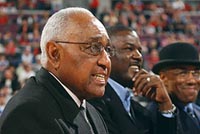 |
In
late April 2008, Will Robinson died at age
96. Never heard of him? Well, let me tell you about this remarkable
man.
In
1970, Robinson became the first African-American
to coach an NCAA Division I basketball team when he was hired
by Southern Illinois.
His best player during his five years with the Salukis
was Doug Collins who, a month after his mentor's
death, was hired for the second time by the Chicago
Bulls as their head coach. In recent years,
Collins said, "To this day, I love him
as a father." |
Born
in a small town in North Carolina in 1911, Robinson
attended Steubenville High School
in Ohio. He earned 14 letters in five sports – football,
basketball, baseball, track, and golf. In 1930, he became the
school's first black QB. The team went undefeated and unscored
on. He was also captain of the golf team. Will
recalled: "We went to the state tournament in Columbus,
and they wouldn't let me play with the others. I started alone
at seven in the morning. I couldn't stay in the dormitory at
Ohio
State. I couldn't eat at the banquet they had
that night. They gave me a sandwich. I finished second."
Another tale he told illustrates the racial attitudes of the
day even in the North. "I remember when I went to a school
counselor and told her I thought I should take up typing, and
she said: 'Typing? Why, you're going to be a janitor.'"
He
attended West Virginia State College,
then an all-Black school, where he earned 15 letters in four
sports – football, basketball, baseball, and gymnastics.
He captained each of those teams except basketball. After earning
his degree in 1937, he coached in a YMCA basketball league in
Pittsburgh before moving to Chicago, where he began his high
school coaching career in 1943. In 1944, he began a 26-year
tenure as a high school coach in Detroit. He coached basketball
and football at Miller High for 13 years, winning
six championships without the benefit of a gym or a home stadium.
He did his best work at Pershing
High where he won state basketball championships
in 1967 and 1970. Five players from his 1967 team, including
Spencer Hayward and Ralph Simpson,
played pro sports.
While
in Detroit, he was hired by the Detroit
Lions as the first black scout in any pro sport.
His job was to cover the traditionally black colleges in the
South. His most famous discovery was Hall of Fame CB Lem
Barney of Jackson State.
After
being passed over for the University
of Detroit head basketball post, he moved to
Illinois State,
where he compiled a 78-51 record in five years with no losing
season. However, he still had to battle racism. Some suggested
the school change its nickname from Redbirds
to Blackbirds.
He had trouble making a schedule and was often verbally abused
at road games. Frustrated, he resigned to join the front office
of the Detroit Pistons
as a scout, a position he filled for 28 years. The players he
found for the Pistons
include Joe Dumars (now the GM), Dennis
Rodman, and John Salley. He didn't
retire until 2003 at age 92.
He
was inducted into eight Halls of Fame in his lifetime in Michigan,
West Virginia, Illinois, and Ohio. Although he spent five frustrating
years at SIU, his selection opened
the door for other black coaches such as George Raveling
at Washington
State in 1972 and Fred Snowden
at Arizona.
Reference:
Will
Robinson – Struggles of a Black Athlete |
Well-Connected Oregon State Coach [posted 6/6/2008]

Coach Craig Robinson
|
In
April, Oregon State hired 46-year-old
Craig Robinson as its basketball coach.
He is the school's fifth coach since Hall of Famer Ralph
Miller retired in 1989. The Beavers
have had only one winning season out of the last 17. At
least three coaches turned down the job before Robinson
took it. Craig brings an interesting
resumé to the task.
- After
growing up in Chicago, he played at Princeton
(another black and orange school like OSU)
under the architect of the "Princeton
Offense," Pete Carril. He led
the Tigers to two Ivy titles and was
selected by the 76ers in the fourth round in 1983. He
played two years in England but not in the NBA.
- He
returned to the U.S. and earned a master's degree in
finance at the University
of Chicago. He then worked eight years
on Wall Street, eventually earning $1 million a year.
- He
kept a connection to basketball, scouting high school
games for Princeton and even coaching
U. Chicago HS for a year.
- Never
finding fulfillment in finance, he took a 90% pay cut
to be an assistant to Carril disciple
Bill Carmody at Northwestern.
He made a name for himself as both a recruiter and a
tactician.
- After
six years in Evanston, Robinson took
over the program at Brown,
winning more games (30) in his first two years than
any coach in the school's history. His 2007-8 squad
won the Ivy League.
|
Robinson
faces a daunting challenge in a job widely considered the
most challenging in Division IA basketball.
- 59-year-old
Gill Coliseum is badly in need of a thorough remake.
- Corvallis
is an out-of-the-way city with 86% white population. Recruits
must be driven two hours from the Portland airport.
- The
Pac-10 is highly competitive. Last year's Beaver
squad didn't win a conference game.
However,
OSU thinks the enthusiasm with which Robinson
turned around Brown
will work out West also. And then there's one other fact
about Craig that might help recruiting
also.
His
younger sister Michelle, who followed him
to Princeton after high school, is Mrs. Barak Obama.
Reference:
"The
Unlikely Candidate", Sports Illustrated 6/9/08
|
This is the first of two related articles that take a trip through nearly one hundred years of basketball history.
In 1917, Eddie Gottlieb and two of his friends, all newly graduated from high school in Philadelphia, formed an amateur team sponsored by the Young Men's Hebrew Association (YMHA). When sponsorship transferred to the South Philadelphia Hebrew Association in 1921, the team became the Philadephia SPHAs, although they were often referred to as the "Hebrews" as they barnstormed across the East and Midwest playing in various semipro leagues, most notably the Eastern League in 1925-6 before it folded. The SPHAs cemented their reputation in 1926 when they defeated the Original Celtics (another team with numerous Jewish players) in three games and the New York Renaissance, an all-black team, in two games.
When the Eastern League was resurrected in 1929, the SPHAs won three championships in the first four years. This won them an invitation to join the American Basketball League in 1933. Coach Gottlieb's team promptly won three of the first four titles and seven in 13 years, finishing second two other times. The team's uniform shirts featured the four Hebrew letters spelling SPHA on the front and, to make sure the spectators got the point, had "Hebrews" on the back.
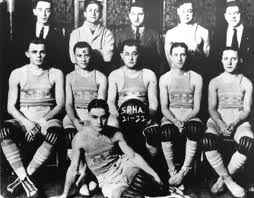
1922 Philadelphia SPHAs
When the Basketball Association of America, the immediate precursor of the NBA, was formed in 1946 to play in large arenas in major cities, Gottlieb became the coach and general manager of the Philadelphia Warriors in the new league and promptly won the first championship. His SPHAs continued as a minor league team in the ABL and also provided the opponent for the Harlem Globetrotters on their worldwide tours.
|
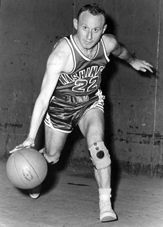 Red Klotz
Red Klotz |
After Eddie Gottlieb became the first coach of the Philadelphia Warriors in the new NBA, his previous team, the Philadelphia SPHAs, played minor league ball and traveled with the Globetrotters as their "stooge" opponent. Finally, Gottlieb sold the team in 1952 to former SPHAs star Red Klotz. Red changed the name to the Washington Generals and made them the Globetrotters' exclusive foe on their worldwide tours. Red supposedly chose his team's monicker in honor of newly-elected President Dwight Eisenhower.
From 1953-1995, the Generals played over 13,000 exhibitions against the Globetrotters. Washington won only six of those games, the last in 1971. That year, the Generals' name was alternated with the Boston Shamrocks, New Jersey Reds, Baltimore Rockets, and Atlantic City Seagulls. But it was the same set of players in different uniforms. Playing as the Reds in Martin TN, Klotz' team won 100-99 when he himself sank the winning basket in OT. Thus ended Harlem's 2,499-game winning streak.
Klotz "disbanded" the Generals in 1995 to form a new team, the New York Nationals. As before, this was merely a name change, not a personnel change. The "new" club embarked on another long losing streak. The Generals returned in October 2007 to start a new season of humiliations.
Globetrotters' History
|
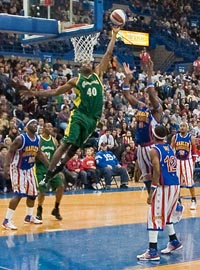 Generals
Generals vs Globetrotters
|
|
|
CONTENTS
Dribble-Drive
Motion
Biggest
Twins in Basketball
What's
a Billiken?
Oscar
Invades the Garden
Loyola
National Champs
First
Black Division I Head Coach
Well-Connected Oregon State Coach
The SPHAs – I
The SPHAs – II
Basketball Did You Know? – II
Basketball Did You Know? – III
Basketball Did You Know? – IV
Basketball Did You Know? – V
Basketball
Magazine
Back to Top |








